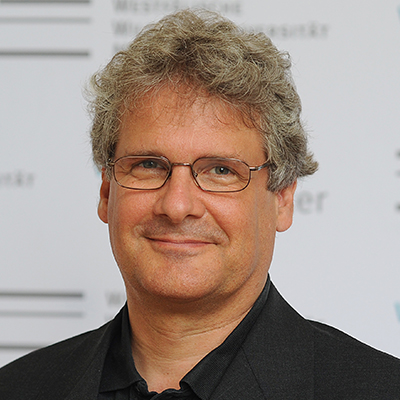“My job isn’t ‘work’ – it’s my life!”

Prof. Klämbt, what scientific topic are you working on right now?
We’re doing work on glial cells, one of the main components of the brain. Essentially, we’re interested in the glial cells that wrap axons and those glial cells that form the blood-brain barrier of invertebrates. Our aim is to understand how these cells function and develop, how they migrate and become differentiated, and how they eventually influence the activity of the brain and thus the movements of the organism. In other words, the lab conducts developmental biology, behavioural biology as well as molecular neurobiology. For this purpose we use fruit flies, known as Drosophila melanogaster. We can work with flies in a much less complicated way than with mice, for example, and we have the tools at hand to switch every gene on or off, at any time. What’s more, flies are shockingly similar to humans: the heart, eyes and brain all work in about the same way. But it’s not that which motivates us – the fact that flies are human beings, so to speak – but the fact that flies are flies. And we want to understand how they function.
What characterizes you personally as a scientist?
The fact that I am still full of curiosity. I do research because I want to understand things. Next year I’ll have been at Münster University for 20 years. It was an enormous stroke of luck that I was able to start here. I am committed with my heart and soul, and in this sense my job isn’t “work” – it’s my life.
What is your greatest aim as a scientist?
I would like to understand how the brain works. But this aim will not be easily reached soon. Possibly, we are not even able to ask the right questions at the moment. There are so many wonders in the brain. To take just one example: a human being is able to catch a fly. The fly moves so fast that the image in brain develops only when the fly had already left its original position. And yet, we hold out our hand at the right place. That’s just incredible. I believe that a scientific question has to be big – bigger than we are.
What’s your favourite toy for research – and what can it do?
Toy? I don’t have any toys – I have tools. And my favourite technical tool is … well, the development of our FIM imaging table has given my colleagues and me an awful lot of pleasure. This instrument enables us to observe the movement of fly larvae. We also need very good microscopes, of course. Imaging is the soul of what we do – although I don’t myself have much time anymore to work in the lab.
Can you remember your happiest moment as a scientist?
The births of my daughters. In science there are so many wonderful things that we experience. Here at the Institute, for example, it’s incredibly gratifying when I have discussions with my PhD students and I feel that we are enriching each other’s lives – and suddenly we have developed an idea together. There are a lot of small moments like that.
And what was your biggest frustration?
People say I’m relatively resistant to stress. I too think I’m pretty even-tempered. Once I got really angry when an outsider was behaving incorrectly in our lab – and people noticed that. Apart from that, I can remember a few frustrating experiences in connection with administrative structures.
Which scientific phenomenon still regularly fascinates you today?
There are lots! Everything we work on here in the lab. There’s a lot about it that we still haven’t understood. And there are new questions arising all the time. There are some really weird things as well: if you switch off a gene with RNA interference, for example, then the phenotype – in other words, the observable traits– is different than if you remove the gene. I find phenomena like that fascinating.
What big scientific question would you like to have an answer to?
Hmm... interesting question. I think the last question I would want to ask myself would be one without an answer. But of course there are a lot of questions I’d like an answer to. Everything we’re working on here. The interim goals, so to speak.
How much artistry, creativity and craftsmanship is there in your scientific work?
Oh, lots. Just look at our scientific images – that’s all creative. And artistic. Do you know Heckel’s “Art Forms in Nature” from the 19th century? That’s full of symmetry and forms. As a scientist, you have to pay attention to forms and be able to interpret them. Sometimes, for example, it’s not very easy to recognize what kind of phenotype you have before you, or why someone is ill. The same is true of art. Whether it’s Expressionism or Surrealism – it’s always a different way of looking at the same thing. But the artist has to be able to depict it. And I think that helps to recognize it. Of course, the artist has more freedom than the scientist, who has to live with the form that nature gives him. To that extent, art is a path to recognition, and science is quite simply the path to knowledge.

